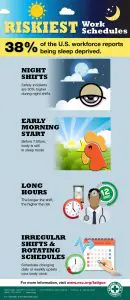Fatigue in the Workplace: A Deadly Occupational Hazard
Generally speaking, American workers aren’t getting enough sleep. In some industries, fatigue at work can be deadly. And some workers are more at risk than others.
 According a 2017 NSC report, fatigue is any sensation of tiredness, sleepiness, reduced energy and an increased effort needed to perform tasks. Fatigue can be caused by many factors, the most common being a poor night’s sleep or the product of a grueling work schedule. Fatigue decreases one’s ability to think clearly and can result in dangerous decision-making and reduced productivity. It is important for employers to understand the underlying causes of fatigue in order to minimize and mitigate those factors that affect the health and safety of their employees.
According a 2017 NSC report, fatigue is any sensation of tiredness, sleepiness, reduced energy and an increased effort needed to perform tasks. Fatigue can be caused by many factors, the most common being a poor night’s sleep or the product of a grueling work schedule. Fatigue decreases one’s ability to think clearly and can result in dangerous decision-making and reduced productivity. It is important for employers to understand the underlying causes of fatigue in order to minimize and mitigate those factors that affect the health and safety of their employees.
The 2017 NSC report polled workers and the data resulted in nine main fatigue risk factors for employers to note: shift work, high risk hours, demanding jobs, long shifts, long weeks, sleep loss, no rest breaks, quick shift returns, and long commutes.
Night shift workers in particular reported reduced alertness due to the night time hours on duty. 17% of people the NSC polled reported working a non-day shift. On average, those people get almost 15% less sleep than day shift workers. This throws off their circadian rhythm, which increases their risk of injury.
Also at risk are those who work a demanding job, such as one that requires sustained attention for long period of time or involves repetitive tasks. Employers in these fields should identify ways to assist employees in remaining focused and alert. Varying the types of tasks during these jobs can also help reduce fatigue.
21% of those surveyed by the NSC reported working ten hours or more each shift. The longer a person is working, the more tired they become and the more likely they are to make safety-critical mistakes. Similarly, those who work long weeks (about 22% of employees) are at a higher risk of sleep deprivation. Experts recommend that employers keep work weeks below 50 hours, so as to allow employees the opportunity to take care of their physical and mental health.
Anther common factor of workplace fatigue is a long commute. Commutes over thirty minutes have been shown to detract from a person’s recuperation after a shift. That person is also at risk for drowsy driving, which is compounded on workplace fatigue and vice versa, creating a vicious cycle for the employee.
Fatigue doesn’t just negatively impact employees. 90% of employers reported being negatively affected by fatigue in their workplace. Fatigue can actually cost employers money. Reduced alertness due to lack of sleep contributes to missed workdays, lower employee productivity, increased health care costs, workplace injuries and motor vehicle crashes. On average, an employer with 1,000 employees can expect to lose more than $1 million each year because of fatigue.
There is a serious gap between how employers and employees view fatigue and its impact on their safety. Notably, 93% of all employers feel fatigue is a safety issue, but just 72% of employees agree. This could point to differences in perception among employers and employees. Employers have objective ways to measure the effects of fatigue: productivity, absenteeism, safety incidents and injuries. Employees may not feel secure in reporting fatigue or, perhaps, employees are not good judges of their own fatigue, signaling a need for employers to invest in fatigue risk management systems (FRMS) and empower employees to participate in sleep health programs.

Riskiest Work Schedules
So how should employers combat fatigue in their workplace? The NSC recommends that night shift employers should limit the number of consecutive night shifts a person can work. It would also help to allow for naps or rest breaks throughout each night shift. 60% of employers have no designated area for employees to rest. A 20-minute nap can help employees stay alert throughout their shift. It is as simple as providing a couch or comfortable chair for night shift employees to take a few minutes to recuperate.
Other options for employers to combat workplace fatigue include providing at least 12 hours of time off between shifts, limiting overtime requirements, and creating an environment where employees feel comfortable talking about fatigue and the safety concerns associated with it. Communicating about fatigue in the workplace increases awareness about its causes, and the associated safety and performance risks.
While some employers might think they’ll profit from allowing their employees to work to the point of exhaustion, fatigue at work actually increases costly mistakes and safety hazards. Because fatigue increases costs, employers who manage workplace fatigue help the bottom line. Some fatigue risks can be managed for little cost: forward rotating shifts, for example. Other strategies for fatigue management, such as hiring more employees or implementing a sleep disorder screening program, are upfront expenditures that may require budget justification to the leadership.
According to the NSC, of all recommended changes, workplace culture may be the most difficult to address because it requires a change in perspective, not just a change in policy. Disciplining employees for reporting fatigue prevents open and honest communication and can hamper future reporting. Working while fatigued is at best less productive and at worst dangerous for the employee, the organization and the public. Employers and employees need to come together to have the conversation on workplace fatigue, which could result in a safer world.
Posted in Munley News.
Tagged Drowsy Driving Hazard Loss









